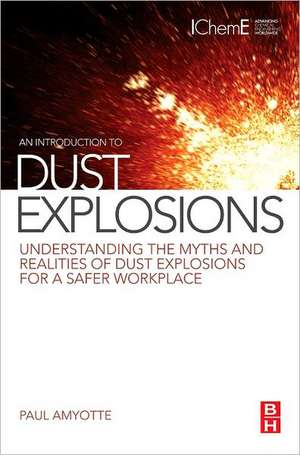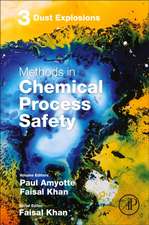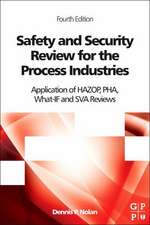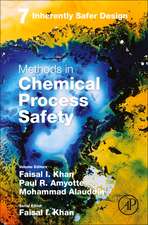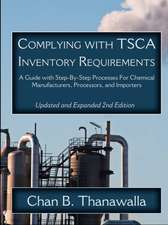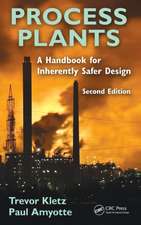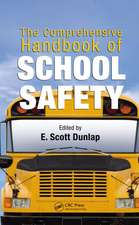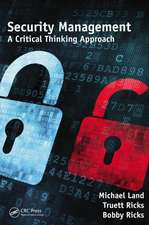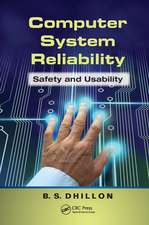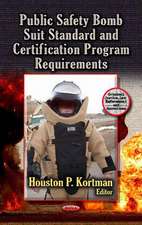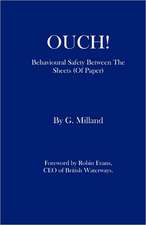An Introduction to Dust Explosions: Understanding the Myths and Realities of Dust Explosions for a Safer Workplace
Autor Paul Amyotteen Limba Engleză Paperback – 2 iul 2013
An Introduction to Dust Explosions describes the main erroneous beliefs about the origin and propagation of dust explosions. It offers fact-based explanations for their occurrence and the impact of such events and provides a critical guide to managing and mitigating dust explosion risks.
- Designed to prevent accidents, injury, loss of life and capital damage
- An easy-to-read, scientifically rigorous treatment of the facts and fictions of dust explosions for those who need to – or ought to – understand dust explosions, their occurrence and consequences
- Enables the management and mitigation of these critical industrial hazards
Preț: 241.57 lei
Nou
Puncte Express: 362
Preț estimativ în valută:
46.23€ • 50.20$ • 38.83£
46.23€ • 50.20$ • 38.83£
Carte tipărită la comandă
Livrare economică 15-29 aprilie
Preluare comenzi: 021 569.72.76
Specificații
ISBN-13: 9780123970077
ISBN-10: 0123970075
Pagini: 280
Ilustrații: Illustrated
Dimensiuni: 152 x 229 x 15 mm
Greutate: 0.45 kg
Editura: ELSEVIER SCIENCE
ISBN-10: 0123970075
Pagini: 280
Ilustrații: Illustrated
Dimensiuni: 152 x 229 x 15 mm
Greutate: 0.45 kg
Editura: ELSEVIER SCIENCE
Public țintă
Process Engineers, Safety Engineers, Chemical Engineers, Mechanical Engineers in the Process Industries, Managers in the Process Industries, Safety ConsultantsCuprins
1. INTRODUCTION: Dust Explosions – Myth or Reality?
2. MYTH NO. 1 (FUEL): Dust does not explode.
3. MYTH NO. 2 (FUEL): Dust explosions only happen in coal mines and grain elevators.
4. MYTH NO. 3 (FUEL): A lot of dust is needed to have an explosion.
5. MYTH NO. 4 (FUEL): Gas explosions are much worse than dust explosions.
6. MYTH NO. 5 (FUEL): It’s up to the testing lab to specify which particle size to test.
7. MYTH NO. 6 (FUEL/IGNITION SOURCE): Any amount of suppressant is better than none.
8. MYTH NO. 7 (IGNITION SOURCE): Dusts only ignite with a high-energy ignition source.
9. MYTH NO. 8 (IGNITION SOURCE): Only dust clouds – not dust layers – will ignite.
10. MYTH NO. 9 (OXIDANT): Oxygen removal must be complete to be effective.
11. MYTH NO. 10 (OXIDANT): Taking away the oxygen makes things safe.
12. MYTH NO. 11 (MIXING): There’s no problem if dust is not visible in the air.
13. MYTH NO. 12 (MIXING): Once airborne, a dust will quickly settle out of suspension.
14. MYTH NO. 13 (MIXING): Mixing is mixing; there are no degrees.
15. MYTH NO. 14 (CONFINEMENT): Venting is the only/best solution to the dust explosion problem.
16. MYTH NO. 15 (CONFINEMENT): Total confinement is required to have an explosion.
17. MYTH NO. 16 (CONFINEMENT): Confinement means four walls, a roof and a floor.
18. MYTH NO. 17 (PENTAGON): The vocabulary of dust explosions is difficult to understand
19. MYTH NO. 18 (PENTAGON): Dust explosion parameters are fundamental material properties.
20. MYTH NO. 19 (PENTAGON): It makes sense to combine explosion parameters in a single index.
21. MYTH NO. 20 (PENTAGON): It won’t happen to me.
22. CONCLUSION: Dust Explosion Realities
INDEX
2. MYTH NO. 1 (FUEL): Dust does not explode.
3. MYTH NO. 2 (FUEL): Dust explosions only happen in coal mines and grain elevators.
4. MYTH NO. 3 (FUEL): A lot of dust is needed to have an explosion.
5. MYTH NO. 4 (FUEL): Gas explosions are much worse than dust explosions.
6. MYTH NO. 5 (FUEL): It’s up to the testing lab to specify which particle size to test.
7. MYTH NO. 6 (FUEL/IGNITION SOURCE): Any amount of suppressant is better than none.
8. MYTH NO. 7 (IGNITION SOURCE): Dusts only ignite with a high-energy ignition source.
9. MYTH NO. 8 (IGNITION SOURCE): Only dust clouds – not dust layers – will ignite.
10. MYTH NO. 9 (OXIDANT): Oxygen removal must be complete to be effective.
11. MYTH NO. 10 (OXIDANT): Taking away the oxygen makes things safe.
12. MYTH NO. 11 (MIXING): There’s no problem if dust is not visible in the air.
13. MYTH NO. 12 (MIXING): Once airborne, a dust will quickly settle out of suspension.
14. MYTH NO. 13 (MIXING): Mixing is mixing; there are no degrees.
15. MYTH NO. 14 (CONFINEMENT): Venting is the only/best solution to the dust explosion problem.
16. MYTH NO. 15 (CONFINEMENT): Total confinement is required to have an explosion.
17. MYTH NO. 16 (CONFINEMENT): Confinement means four walls, a roof and a floor.
18. MYTH NO. 17 (PENTAGON): The vocabulary of dust explosions is difficult to understand
19. MYTH NO. 18 (PENTAGON): Dust explosion parameters are fundamental material properties.
20. MYTH NO. 19 (PENTAGON): It makes sense to combine explosion parameters in a single index.
21. MYTH NO. 20 (PENTAGON): It won’t happen to me.
22. CONCLUSION: Dust Explosion Realities
INDEX
Recenzii
"Amyotte arranges his treatment around 20 common myths about dust explosions, and the realities they hide, with a further organization by elements of the explosion pentagon: fuel, ignition source, oxidant, mixing, and confinement. Among the myths are dust explosions happen only in coal mines and grain elevators; dust ignites only with a high-energy ignition source; taking away the oxygen makes things safe; airborne dust will quickly settle out of suspension..." --ProtoView.com, January 2014
"For those working with powders and dusts, then this small, unusual book makes entertaining and interesting reading…The book should be essential reading for all managers, engineers, and scientists working in the chemical and related industries (e.g., food, where dust explosions are, unfortunately, quite common), since all dust explosions are preventable if the correct equipment is installed, the correct procedures are followed, and staff are properly trained." --Organic Process Research & Development online, December 24, 2013
"For those working with powders and dusts, then this small, unusual book makes entertaining and interesting reading…The book should be essential reading for all managers, engineers, and scientists working in the chemical and related industries (e.g., food, where dust explosions are, unfortunately, quite common), since all dust explosions are preventable if the correct equipment is installed, the correct procedures are followed, and staff are properly trained." --Organic Process Research & Development online, December 24, 2013
